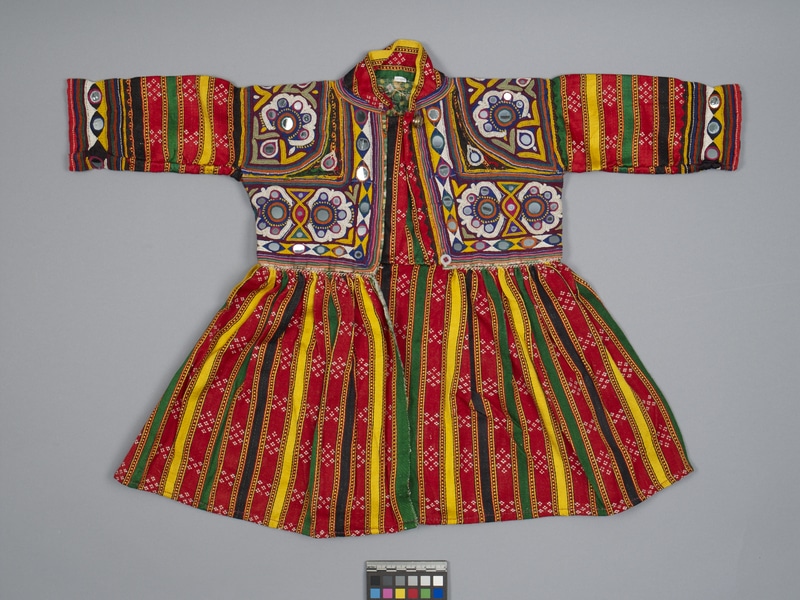shirt Item Number: 3132/1 from the MOA: University of British Columbia


Description
Embroidered boy's shirt. Long-sleeved, collared shirt is made of mashru cloth, a mix of cotton and silk, coloured in vertical stripes of red, yellow, green and black with sets of small white dots regularly scattered across the red. Chest and back are heavily embroidered with flowers, mango tree designs, and 'v' shaped animal horns. Small mirrors are inset on chest, back and around cuffs, surrounded by sickle stitching. A decorative gold metal button fastens the shirt at the collar, with a plastic button at waist. Two ties on the interior also help hold the garment closed.
History Of Use
Married women make kediyun traditional shirts and other embroidered clothing for children and grandchildren. The motifs represent elements intrinsic to everyday life; each has specific names and meanings. Tiny mirrors are added to clothing to protect the wearer from negative spirits. In the past, boys would have worn these shirts frequently but now they are more likely to be worn only for special occasions, such as religious festivals and weddings.
Narrative
Cultural group known as both Rabari or Rewari, depending on whether they live in Gujarat or Rajasthan.
Specific Techniques
Prior to embroidery, pieces of green cotton were stitiched into the bodice. The cotton is then so heavily embroidered it is invisible from the outside. The material used to create the rest of the garment is a traditional blend of cotton and silk threads called 'mashru'. Mashru was once woven all over India, but today its manufacture survives only in Gujurat state.
Item History
- Made in Rajasthan, India ? or Gujarat, India ? before 1994
- Collected in Pushkar, Rajasthan, India during 1994
- Owned by Gillian Darling Kovanic
- Owned by Rudi Kovanic before September 29, 2015
- Received from Rudi Kovanic (Donor) on September 29, 2015
What
- Name
- shirt
- Identification Number
- 3132/1
- Type of Item
- shirt
- Material
- cotton fibre, silk fibre, glass, metal, plastic and dye
- Overall
- height 51.0 cm, width 71.0 cm
Who
- Culture
- Rabari
- Previous Owner
- Gillian Darling Kovanic and Rudi Kovanic
- Received from
- Rudi Kovanic (Donor)
Where
When
- Creation Date
- before 1994
- Collection Date
- during 1994
- Ownership Date
- before September 29, 2015
- Acquisition Date
- on September 29, 2015
Other
- Item Classes
- textiles
- Condition
- good
- Accession Number
- 3132/0001